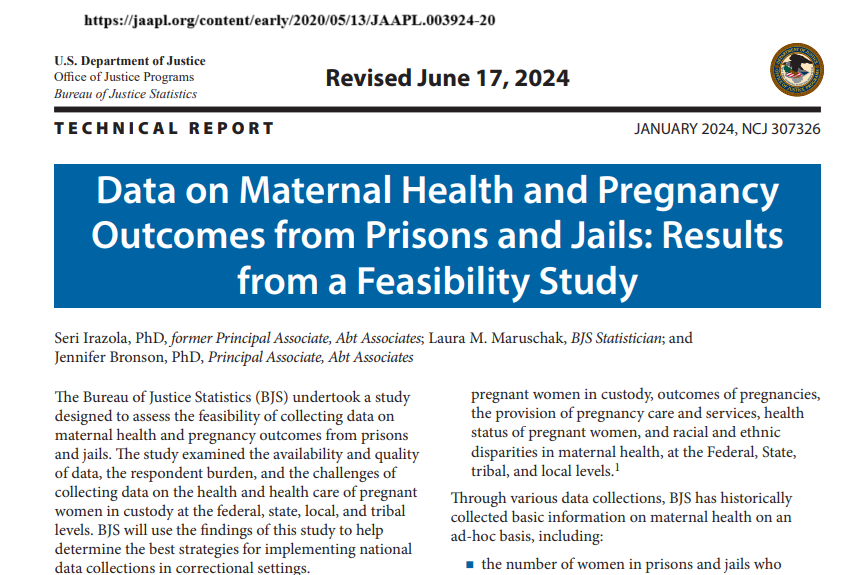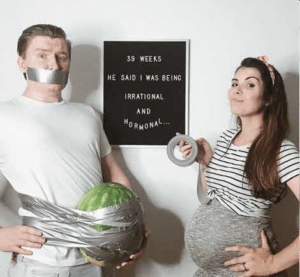Pregnant In FEDERAL Prison. Are You Eligible For The MINT Program?
IS THIS YOU?
INDICTED AND FACING PRISON
Pregnant In FEDERAL Prisons
A significant percentage of women entering prison are of the age where they’re sexually active, are either at risk for pregnancy or are already pregnant. A 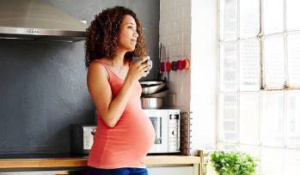 2019 study reported that a total of 4% of women in federal custody were pregnant, and 753 gave birth (Sufrin, 2019).
2019 study reported that a total of 4% of women in federal custody were pregnant, and 753 gave birth (Sufrin, 2019).
Most women entering prisons are mothers, as well as the primary caregivers to young children (Glaze & Maruschak, 2010). It would be helpful if facilities (federal and state) made a conscious effort to recognize the resulting psychological difficulties that result when forced separation occurs following childbirth.
While it’s a lot to ask, creating areas for new mothers to pump breast milk for their infants and then having a place to store it goes a long way in allowing them to establish their relationship with their new child, at a minimum.
NCCHC Has Set National Standards for Pregnancy-Related Health Care in Correctional Settings
- Pregnancy and Postpartum Care
- Restraint of Pregnant Inmates
- Breastfeeding in Correctional Settings
- The NCCHC standard titled P-G-O7 “State Standards for Pregnancy-Related Health Care in Prison.”
- The NCCHC standard titled P-G-09: “STATE STANDARDS FOR PREGNANCY- RELATED HEALTH CARE AND ABORTION FOR WOMEN IN PRISON
ACOG: specialists in Obstetrics and Gynecology, “The use of restraints on pregnant incarcerated women not only compromise health care but are rarely necessary.”
Federal – While onsite nurseries are unavailable, they have limited offsite programs.
- MINT: Mothers and Infants Together (MINT) Program (GAO, Page 7 cxxvi9)
- RPP: Residential Parenting Program (RPP) (GAO, Page 82 cxxvii).
- A reason to be very proactive:
Department of Justice Office of the Inspector General, Review of the Federal Bureau of Prisons Management of Its Female Inmate Population, Evaluations and Inspections Division 18-05 (Washington, DC: September 2018).
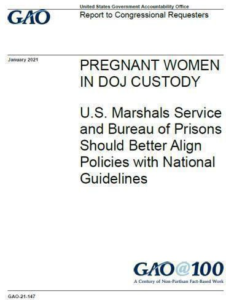 An interview with an Assistant Federal Public Defender (Page 82 bottom
An interview with an Assistant Federal Public Defender (Page 82 bottom
- They found the lack of information and communication about the MINT program for pregnant women facing prison time problematic.
- Specifically, as pregnant women await sentencing, they do not have a sense of what to expect, or decisions they need to make in terms of medical care or custody of their infant.
- Despite their and the judge’s efforts to contact BOP and MINT programs, BOP was not forthcoming with any substantive information about how to initiate the approval process for MINT participation while the defender’s pregnant client awaited sentencing.
The views expressed by the defender are their own and do not represent the views of the Administrative Office of the U.S. Courts or the federal judiciary.
Mothers and Infants Together (MINT) Program (GAO-21-147 Pregnant Women in DOJ Custody, Page 79cxxix)
- BOP policy allows eligible women to enter MINT during the last two months of their pregnancy.
- They can stay at least 3 additional months after giving birth.
The policy recommends a minimum of 6 months (P5200.02 11/23/2016 Federal Regulations from 28 CFR: this type. Implementing instructions: this type, page 16cxxx).
I) Fort Worth, Texas (Mothers and Infants Nurturing Together (MINT)Program, Tx. cxxxi);
CONTACT: The “Little House”, houses the MINT women and their babies. Volunteers of America Texas, 2710 Avenue J., Fort Worth, Texas 76105, 817) 535- 0853 BOP (PS 5200.02, CN-1cxxxii):
0853 BOP (PS 5200.02, CN-1cxxxii):
- If RRC placement is medically appropriate and documents this on the Medical/ Psychological Pre-Release Evaluation (BP-A0351), which is forwarded to Unit Management.
- Direct court commitments have a secondary designation noted on the Inmate Load and Security Designation form (BP-A0337).
From the GAO-21-147, Pregnant Women in DOJ Custody, Page 79cxxxiii
- They also have a Residential Reentry Center for men.
- They work to reduce recidivism and the stigma for children born to incarcerated parents by enhancing the bond between the mother and infant while teaching the women how to care for their infants and be better citizens.
- Women have a weekly check-in with a nurse and are taken outside of the facility for prenatal care.
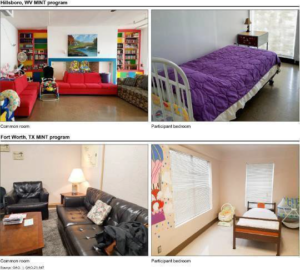
- The program holds up to six women at one time.
- They usually have approximately two or three participants at any given time,
- And approximately 10 participants annually.
- The women typically stay 3 months postpartum and BOP officials noted that women may request an additional month extension (PS 5200.02, CN-1, page 16).
When interviewed by GAO staff, the women stated that they received regular medical care, including any special care that was needed and any special accommodations that they requested.
- The mother is then returned to an institution to complete her sentence, if necessary.
II) The Greenbrier ‘MINT’ Program, WV cxxxiv.
CONTACT: Operates under The Baltimore Residential Reentry Office, Baltimore, Maryland, Appalachian Mountains in Pocahontas County, Hillsboro, WV. Facility Director: Starlena Robertson, Case Manager’s Susan Lane or Mary Eggert, (304) 653-4882 or (304) 653-4570,
 mint3vz@frontiernet.net BOP (PS 5200.02, CN-1cxxxv):
mint3vz@frontiernet.net BOP (PS 5200.02, CN-1cxxxv):
- If RRC placement is medically appropriate and documents this on the Medical/ Psychological Pre-Release Evaluation (BP-A0351), which is forwarded to Unit Management.
- Direct court commitments have a secondary designation noted on the Inmate Load and Security Designation form (BP-A0337).
- Here they promote maternal bonding and parenting skills in a home-like environment.
- No medical care is provided on-site.
- Mental health providers offer onsite services twice weekly, and women are taken outside of the facility for prenatal care.
- The program has ten staff and can hold up to 20 women simultaneously.
- The program has approximately 10 participants at any given time and approximately 20 annually.
- The women typically stay for 3 months postpartum, and BOP officials noted that women may request an additional 6-month extension (PS 5200.02, CN-1, page 16).
- When interviewed by GAO staff, the women stated that they received regular medical care, including any special care that was needed and any special accommodations that they requested.
- One woman stated that she appreciated the welcome basket she received upon arriving at the Hillsboro MINT program of donated items such as toiletries for the woman, as well as infant clothing and accessories.
- The mother is then returned to an institution to complete her sentence if necessary.
III) Residential Parenting Program (RPP), Washington State Department of Corrections cxxxvi
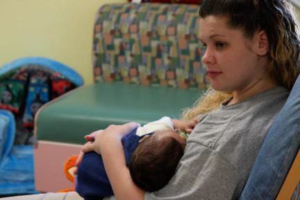 CONTACT: Sonja Alley, Correctional Unit Supervisor, Washington Corrections Center for Women, Washington State Department of Corrections (253) 858-4200 X 8274, sonja.alley@doc.wa.gov
CONTACT: Sonja Alley, Correctional Unit Supervisor, Washington Corrections Center for Women, Washington State Department of Corrections (253) 858-4200 X 8274, sonja.alley@doc.wa.gov
BOP (PS 5200.02, CN-1):
- The Unit Team completes the BP-A0210, Institutional Referral for CCC Placement, and submits it to the Seattle Residential Reentry Manager.
- Furloughs are only accepted Tuesdays through Thursdays at RPP. Release residence can be to any state.
- The Designation and Sentence Computation Center (DSCC) may also refer initial designations to the Seattle Residential Reentry Manager, with a copy to the Female Offender Branch Administrator.
GAO: Appendix IV: Mothers and Infants Together and Residential Parenting Program (page 82cxxxvii).
- Teaching Parenting and infant-child bonding to Incarcerated mothers.
- Pregnant women who have 30 months or fewer left on their sentences can participate in RPP.
- The goal is to have the child leave prison with the mother as she reenters the community through workrelease.
Eligibility & Mandatory Requirements
- Only women who are pregnant upon arrival may be eligible for the RPP.
Inmates are screened carefully, and participation criteria include:
- Be pregnant upon commitment, with an expected delivery date prior to release.
- Be scored as Minimum security with Out or Community custody.
- Have release dates or home detention eligibility dates within 30 months of the expected deliverydate.
- Have no 200 or higher series incident reports in the last six months.
- Have satisfactory or higher work evaluations (if available).
- Be clear of all serious disciplinary violations of an aggressive/assaultive nature.
- Have no current no-contact orders with minor children, no sex offense convictions, no crimes against a child, no domestic violence or other violent convictions, and no contact-founded allegation or inconclusive referrals for neglect or abuse with Child protective services.
- Be physically and mentally capable of caring for a child as determined by medical and mental healthcare staff.
- Volunteer and acknowledge program participation entails involvement in prenatal and post-natal programming related to parenting, use of the child development center and approved inmate caregivers and maintenance of a schedule.
Participants Are Required To:
Get involved in pre-and-postnatal programs, such as:
- Parenting skills, child development, self-care and self-esteem, positive discipline, nutrition, and family life skills.
- Structure their various commitments to accommodate the needs of their children.
- Utilize the child development center and approved inmate caregivers.
- Work with facility staff to develop a case plan to address their programming needs including program requirements.
Participate in educational components that teach:
- positive and effective parenting skills,
- give children care that focuses on their developmental and educational needs.
GOALS
- Provide a safe residential setting that will allow infants and their incarcerated mothers to remain united
- Ensure a secure, healthy attachment is formed between mother and child.
- Maximize the infant’s healthy growth and child development.
- Educate the mother in skills to effectively parent and work toward self-sufficiency.


